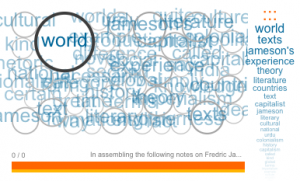Patrick Grady O’Malley
For the text analysis assignment, I used as more corpus to literary theory articles: Jameson’s Third-World Literature in the Age of Multinational Capitalism and a response to that very article by Ahmed, Jameson’s Rhetoric of Otherness and the ‘National Allegory.‘ I chose these two articles as my corpus because I wanted to play around with theoretical texts in response to my latest blog post. In the future, I would consider looking for importable text files of literary examples discussed in these articles, to compare and contrast what could be found in the theoretical work versus the literary.
One weakness I noticed right of the bat, or maybe it is my own ignorance to the tool, but I would have liked to have been able to load the two different articles separately but been able to look through the results comparatively. In other words, I wanted to have separate results but in the same window/screen. Right now, I am just operating with two different browser windows of Voyant and looking back and forth amongst them.
The first notable thing of the results is that the word “world” is by far the most frequent word of both texts. This is not surprising considering they are articles on world literature. Since Jameson’s article is theoretical in nature and Ahmed’s is a response to that work, the differences begin to pile up after that one similarity. In Jameson’s article, the next four most frequent words are “cultural,” “political,” “social” and “new.” These seem to sum up the theme of most of what he was saying throughout the article the argued for the necessity of considering first, second and third-world literature through different lenses. Ahmed’s piece was argumentative to that standpoint, and one of his major contentions was thinking of world literature as all of one world. So his next four most frequent words were less thematic in nature, and more supportive of his argument. They are “texts,” “Jameson’s,” “experience” and “theory.”

Jameson’s word cloud

Ahmed’s word cloud
As you can see in the word cloud images, there is some overlap of word distribution, namely “world” and “literature.” But what I find striking is how Jameson’s article (as per the word cloud) emphasizes the “social” and “political” in a broader sense, with these two word respectively appearing in the word cloud. However, in Ahmed’s critique, the social and political are less nuanced and more direct with words such as “capitalist,” “colonialism,” and “Urdu.” This would make sense considering Ahmed’s piece is a critique, and his argument is more specific and less generalized than Jameson’s overarching work.
“World literature” is the most commonly appearing collocate in both articles. What is interesting is that Jameson’s second most frequent collocate is the writer Lu Xun (and Lu Xun’s), which with both the name and the possessive counted together, actually appear more than “world literature.” He spends a good deal of time discussing the work of Xun, but he also talks about other authors, so I am surprised Lu Xun and his possessive had such frequency.
One could also see through the collocates my point about Ahmed being more specific of particular types of theoretical or political issues. He has collocates near the top such as “experience/imperialism,” “experience/colonialism,” “capitalist/world,” and “Jameson’s/rhetoric.” Meanwhile, Jameson’s top collocates are more optimistic in nature: “world/culture,” great/great” and “world/intellectual.” I suppose it could be argued that in Jameson’s collocate “world/intellectual” that Jameson is personifying that intellectual with the appearance of his own name and rhetoric as one of Ahmed’s top collocates.

Jameson’s word bubble

Ahmed’s word bubble
It is striking that Ahmed’s word bubble is the one to include literature, as that is the focus of really both articles. “Social,” “cultural,” “political” and “new” in Jameson’s attests to his work being more descriptive and larger in scope than Ahmed’s rebuttal, which takes a close reading of the article and responds very specifically.
Overall, I can see how mining the text of theoretical works can be very useful in building a corpus of theory that can help with my research goals. Distant reading of theoretical works shows the overall nature of the work at a surface level and the prevalence of concepts and themes at a closer level.


Very good point about viewing the results comparatively, it seems that feature would have benefitted a few in this class alone.
I agree! I also wanted to view results comparatively and found that I couldn’t. Another thing I’d like to be able to do in Voyant is rename my samples, because I didn’t realize that the names were too long to read in the frequency graph until I had already done a lot of work reordering them, so I didn’t go back to my data and rename the files, re-upload and so on. I hope I remember to name files with short names next time.
Me too, and also ended up with the dual browser window workaround instead